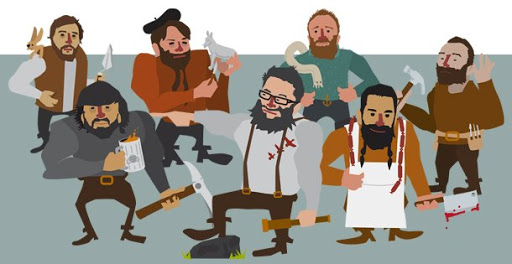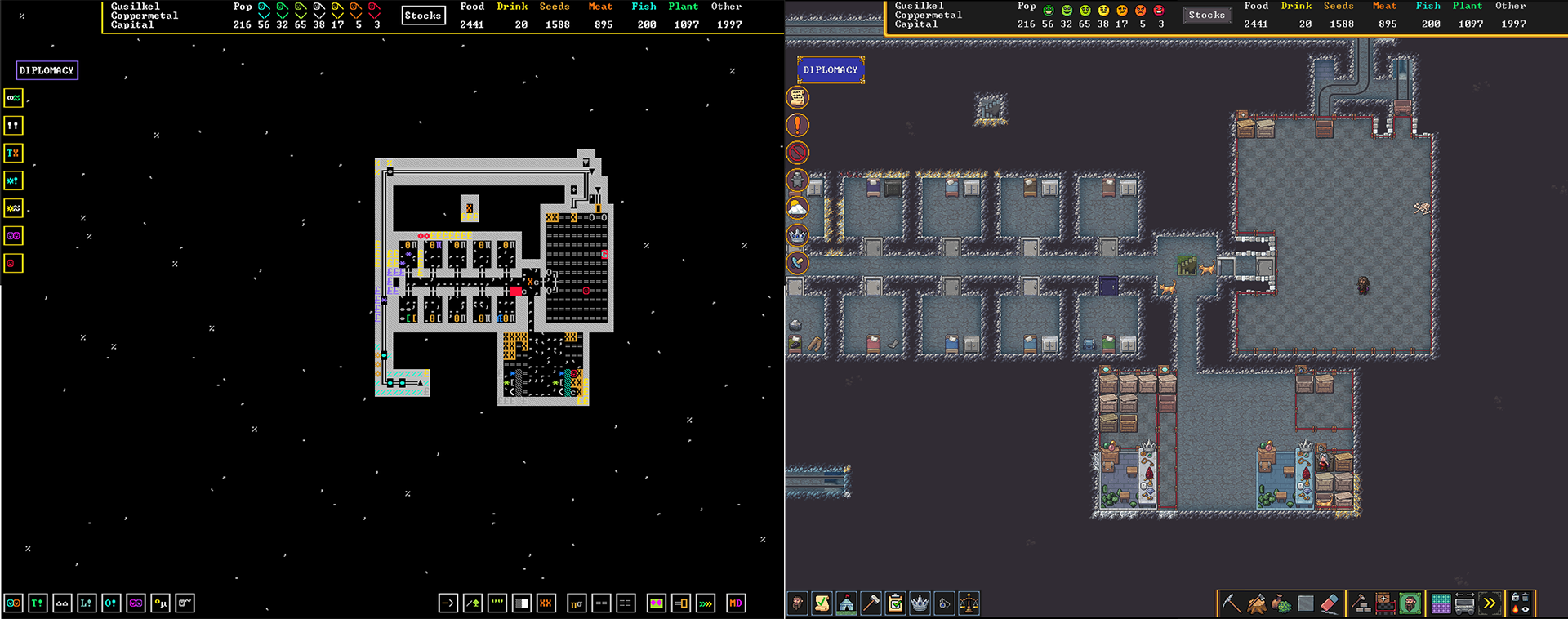
When Dwarf Fortress creators Tarn & Zach Adams talk about the games that inspired them growing up, they're almost all RPGs—so how did they end up making the PC's most famous management simulation and not an RPG? Part of the answer is that they did make an RPG. They just decided to build it inside their management sim. Adventure mode in its current form lets you create a party and go on a roguelike journey through a world you generated in Fortress mode, to directly explore what you were once lording over from above.
But Adventure's always been a bit aimless (and for years at a time, pretty broken) because it lagged behind as a secondary mode, gaining new possibilities as the primary Fortress mode grew more and more complex. Now that Dwarf Fortress has launched on Steam, the Adams brothers are planning to give the mode a major update, beginning with its own UI and graphics overhaul. It's a big project, one that will likely take 2023 to complete before Adventure makes its way to the Steam version of the game.
The way they described it to me in an interview during the Game Developers Conference last week, Adventure mode will finally be getting its due.
A grand adventure
Zach Adams: This is just gonna blow everyone's mind. The people who play it on Steam, maybe less than half of them even know there is an Adventure mode. It opens the entire world for someone to see like you're there. You're exploring the world and seeing how giant it is. If you took a square and it was 6x6 feet, then the play area would be the size of New Zealand.
Tarn Adams: In Fortress mode, you're just in one little part of the world. You know the rest of the world exists and you're kind of interacting with it, you can send people out, but you can't see where they've gone.
Zach: It sucks because it already exists! The Steam version already has all this stuff in it, but we need to bring it to the surface and give it graphics. It's already done, we just have to bring it out.
Tarn: Another long, long project.
Zach: We are leaning towards making it a big release. Yeah. Okay, yeah. We are going to do it. We're going to take away all the little design flaws that are in it right now.
Tarn: Little, and large [design flaws].
Giving Adventure mode more distinct quests
Zach: Before the Steam release was a consideration, we'd already been working on kind of a quest system, at least an adventurer's memory of where things were and what's going on. And that is kind of what we're going to start working on I think.
Tarn: The villains release, too, was kind of a reimagining of the quest system into things that could be multi-part.
Zach: It's not like a quest in a typical roleplaying game. A quest is just giving organization or meaning to what's going on. In Adventure mode, in the original game that's still on our website, you're just wandering from town to town, and there'll occasionally be some quest to kill a night troll. That's just one combat in the middle of a giant game, where you're just wandering around talking to people and them telling you "It's inevitable, of course" or whatever. We're going to have conversations make more sense, quests make more sense, that sort of thing.
Tarn: We're going to make the world more interesting to free roam. The trick of the villain release—in Fort mode, people out in the world can plot to heist your artifacts. And this is a multi-stage process where they literally have to send themselves or an agent to your fortress, turn one of your dwarves using like John le Carré spy techniques. There's a thing called MICE (money ideology, compromise, and ego), counterintelligence stuff. [They use that] to flip a dwarf. And then the dwarf would go off and steal the artifact.
Zach: The artifact is something that you created in Fortress mode, and then in Adventure mode, you have to go save it from the goblins and bring it back.

Tarn: But you wouldn't just go get it. You wouldn't even know where it was. The concept of investigation is kind of central to what we want to do with Adventure mode. If something was stolen, for instance, you'd go talk to people and they'd be able to get you to find this dwarf that took it. There's a certain amount of giving of information where maybe you don't deserve it—traditional RPGs are just horrible with that, everyone knows everything about what's going on. People leave notes. We were thinking about people just carrying things on them, like when a villain sends an agent to a fortress, like in a traditional RPG they're carrying a note in their pocket signed with the villain's first initial telling them what they're supposed to do.
Zach: Procedurally generated clues.
Tarn: Hopefully that'll take us to our first multi-stage plots. They don't last 60 hours like a big BioWare game or whatever, but we edge towards that as this system gets more robust.
We've always been stuck in a weird halfway point [in terms of RPG mechanics]. Partially because we don't have magic in the game. But we do have item quality, which would be equivalent to like a D&D "plus." We have materials. We have skills, which you increase through usage, which gets you some sort of leveling component. We also have reputation, which would be kind of like the form of gating in an RPG—you get to a certain level of reputation to open up faction quests, for instance. It's similar in Dwarf Fortress. The more night trolls you kill, then you might get something like killing a dragon. That's how it currently works, and we want to make that a lot more interesting.
The mechanics are kind of sitting out there. Also party mechanics—you can have a bunch of NPCs join you or in character creation create as many characters as you want and start with a party. There's horses you can ride, you can have pets of all kinds.
Zach: This is already done!
Tarn: There's a lot to recommend, even in an unchanged—aside from graphics and UI stuff—Steam Adventure mode. We just want to make it even better.
Zach: Just to blow everyone's mind and show them how big the world actually is.
An adventure in new UI

Zach: The travel mode is at a different scale [than Fortress mode], so that has to be redone. And the UI has to be redone.
Tarn: It's a turn-based game, it's different from Fortress mode in that way, so we have the opportunity to do things like "swishes" when you miss an attack and have audio for it. Whereas in Fortress mode it'd just be a jumble of icons and audio all at once. In this environment we can do that. So there'll be some UI, travel mode maps…
Zach: A lot of the graphics for the main play area, we were thinking about resolving some more of the way the player looks, making characters look more unique. Otherwise the humans all have the same haircut.
Tarn: There's a couple things. We've already drawn all these human hairstyles but they don't use them. That's really a code change, making human cultures more diverse. The thing here that we want to see if we can do, and we don't know if it'll work, is procedural faces. Like blown-up portraits when you're talking to people, and these would go right on the dwarf character sheets, too. The question is—this is pixel art, we've got our pixel artists working with these paragraphs describing the dwarves that say like 'their ears are wide and stick out and their chin is narrow'—is this going to translate in a satisfactory way to gluing these faces together with pixel art?
Zach: It's going to be a project equal to the ramp thing we did, where we had like 50 different ways the ramp between z-levels could be configured when next to another ramp, next to another level and whatnot.
Tarn: Artists haven't started yet, but they're going to have plenty of time to check it out and report back. We have a lot of leeway here with our timetable to let the artists experiment with stuff.







